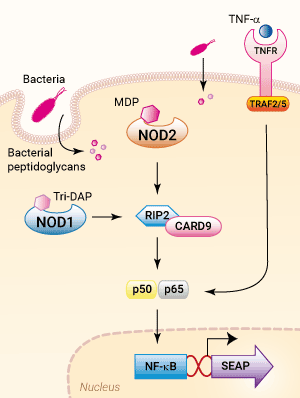HEK293 NOD Reporter Cells
InvivoGen offers HEK293-derived SEAP Reporter cells expressing human or mouse NOD

Signaling pathways in HEK-Blue™ NOD cells
InvivoGen introduces HEK-Blue™ NOD cells, a collection of engineered HEK293 reporter cell lines designed to provide a rapid, sensitive, and reliable method to screen and validate NOD agonists or antagonists.
The Nucleotide-binding Oligomerization Domain-containing proteins NOD1 and NOD2 (also known as NLRs, CATERPILLERs, or NALP/PAN/PYPAFs) are cytosolic pattern recognition receptors, specialized to sense distinct motifs of peptidoglycan (PGN), an essential constituent of the bacterial cell wall. NOD1 senses the D-γ-glutamyl-meso-DAP dipeptide (iE-DAP), which is found in PGN of all Gram-negative and certain Gram-positive bacteria. NOD2 recognizes the muramyl dipeptide (MDP) structure found in almost all bacteria, acting as a general sensor of bacterial invasion.
HEK-Blue™ NOD cells stably express the human or mouse NOD1 or NOD2 together with an NF-κB-inducible SEAP reporter gene. SEAP (secreted embryonic alkaline phosphatase) activity upon NOD stimulation can be readily determined by performing the assay in HEK-Blue™ Detection. This cell culture medium allows for real-time detection of SEAP. Alternatively, SEAP activity may be monitored using QUANTI-Blue™, a SEAP detection reagent.
Key Features
- Verified overexpression of human or mouse NOD1 or NOD2
- Strong and stable response to their specific ligands
- Distinct monitoring of NF-κB by assessing the SEAP activities
Applications
- Defining the distinct role of NOD in the NF-κB-dependent pathway
- Studying the differences between murine and human NOD
- Screening for NOD1-specific agonists or inhibitors in comparison with their parental cell lines
These cell lines are extensively tested for viability, stability, biological activity, and absence of mycoplasma to ensure strong and reproducible results. Moreover, we provide detailed handling and experimental procedures for all cell lines, to minimize the need for optimization or troubleshooting by the end-user.
![]() Read our review on NOD1 & NOD2: Nod-Like Receptors
Read our review on NOD1 & NOD2: Nod-Like Receptors



